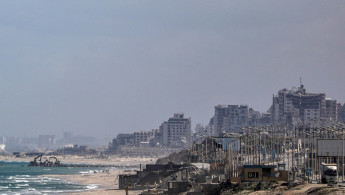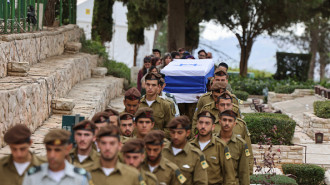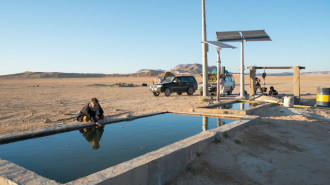Palestinians concerned about 'US occupation' of Gaza via aid pier
Palestinians have expressed fears over a looming US "occupation" of war-torn Gaza after Washington recently announced it established a pier off the besieged coastal enclave.
Speaking to The New Arab, locals in the Gaza Strip revealed that huge American ships had been spotted moving toward the shore of Gaza City as US security crews supervised the construction of the controversial pier.
On Tuesday, top US diplomat Antony Blinken said that the pier, which will reportedly be used for delivering aid to the besieged enclave, will be ready "within a week".
Blinken said that the first aid shipment heading directly from Jordan to the Beit Hanoun crossing will depart on Tuesday.
"The naval pier will support efforts aimed at delivering aid to civilians in the Gaza Strip," the US Army Central Command said in a post on its X account.
On Monday, the Pentagon said that the cost of building the pier will be at least $320 million.
According to a US Army official, the total number of deliveries via the sea route will initially be about 90 trucks per day, and could quickly increase to around 150 trucks per day.
Palestinians in the Gaza Strip remain sceptical about the US intentions of the pier and wonder if this could be part of a long-term collaboration with Israel to occupy the territory.
🧵Israel's war on Gaza:
— The New Arab (@The_NewArab) May 1, 2024
👉US Sec. of State Antony Blinken urges Hamas to accept truce deal
👉 Israeli PM Benjamin Netanyahu vows to send troops into Rafah
👉Death toll: 34,568 Palestinians killed by Israeli forces (77,765 injured)
🔴Live updates: https://t.co/fT3XL8O6vc pic.twitter.com/Bt8ZzHqZyi
For the past week, Nidal Abu Samra, a Deir al-Balah-based Palestinian man, has monitored the movement of the US ships, which can be seen docked off the city's shore.
"I have never seen such huge ships even once in my life... they can't be ships carrying humanitarian aid," the 42-year-old, who has never left the strip, told TNA.
"They look as if they are warships preparing to wage a war on land," he said, pondering about the tremendous speed at which the floating dock was constructed and the real purpose of the pier.
Abu Samra deplored the timing of the pier, which came as Gaza was suffering "systematic starvation and displacement" by Israel and emptied many of the enclave's towns and villages of their inhabitants.
The middle-aged man believed that the primary goal of establishing such a pier in Gaza was to help found a new colonial settlement outpost in the Gaza Strip under US and Israeli management.
Islam Al-Astal, a Palestinian woman displaced from Gaza City, fears the construction of the US pier will begin a long-term security arrangement for the area which will prevent other displaced persons from returning to their homes in the northern city.
"We do not know what is going on here and why construction is being done on the sidewalk... It would have been better to stop the fierce Israeli war against us," the 36-year-old mother-of-three told TNA.
"It seems that the US and Israel have agreed to create a new fait accompli in Gaza and to force the residents here to accept what is being created, whether it is the floating dock or even the presence of American military soldiers."
Al-Astal also fears that the US - a long-term ally of Israel and a supplier of many of the bombs used to destroy Gaza - will use the port to establish a long-term occupation of the enclave with Israel.
Facing financial obstacles and cutbacks, is the ambitious Saudi plan to redefine the nation, now past the halfway mark, still on track?
— The New Arab (@The_NewArab) May 1, 202
Read 🔗 https://t.co/5vE5TPNbzz pic.twitter.com/3IwJD7XJoj
Since Israel launched its devastating war on the enclave on 7 October, approximately 80 percent of Gaza's buildings have been destroyed or are now unlivable, according to Salama Maarouf, head of the Government Media Office in Gaza.
The United Nations believes 37 million tonnes of rubble, caused by seven months of intense Israeli bombing, will have to be removed from the enclave.
"We have about 300 kilogrammes of rubble per square meter in the Gaza Strip, which before the war was densely populated and urban," Per Lodhamar, an official in the United Nations Mine Action Service said during his statement to the United Nations in Geneva on April 26.
Even if 100 trucks were deployed it would still take 14 years to remove the rubble in Gaza, while the presence of unexploded ordnance in the mix would greatly complicate the task, Lodhamar said.
Iyad Al-Qara, a Gaza-based Palestinian political analyst, accused the US of capitalising on the wholesale destruction of Gaza to make inroads into the enclave via the aid pier.
"The US's insistence on building such a controversial project from the rubble in Gaza and ensuring the presence of its forces near this port or on the coast of the Gaza Strip raises many security [questions] and there is the possibility that the US will seek a military presence in this region for goals that have not yet been determined," al-Qara said.
"If the goal is to bring aid into the Gaza Strip, there are many [other] appropriate and convenient ways, including the possibility of increasing the number of trucks that reach the strip through the Rafah land crossing."
He said the port could provide a convenient cover for a long-term US-Israeli military presence near the Al-Rashid Street area, west of Gaza City, which could continue even after a truce is reached and a fait accompli is imposed.
"The aid that the US provides to Gaza cannot be viewed in any positive way, as it is not a supporter [of Palestinians] but rather a clear partner in the war on Gaza," he said.
"Washington provided absolute support to Israel for the crimes being committed in the Gaza Strip."





 Follow the Middle East's top stories in English at The New Arab on Google News
Follow the Middle East's top stories in English at The New Arab on Google News


